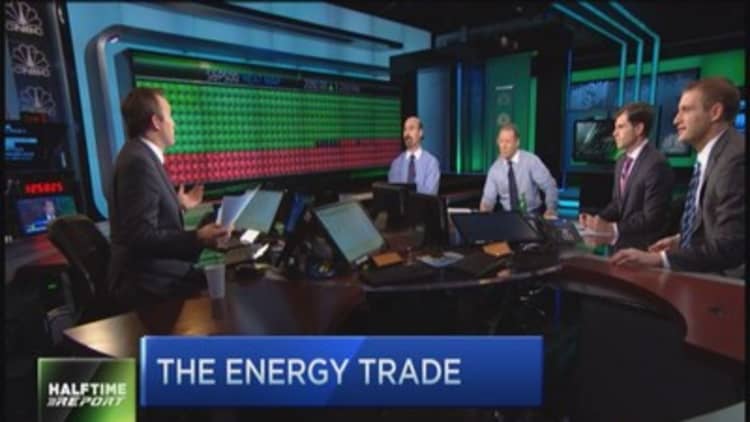
It's news to no one that energy was the bad boy of 2014. Surging U.S. production and slowing demand halved the price of oil and made the energy sector the year's worst performing one amid a broader bull market.
But at some point, there has to be a bottom in oil prices, and investors who look past the obvious (and understandable) fear will make a lot of money, right? C'mon, you know you've been thinking about it. And if you haven't been, you're violating Warren Buffett's No. 1 rule of investing: The best time to be greedy is when everyone is fearful. And you're out of step with market peers who are not being so timid: Broad energy ETFs have seen huge inflows this month.
The energy sector is worth a look even for investors wary of a short-term rebound trade. It has notched solid long-term returns, outperforming the S&P 500 seven years out of the past 10, according to S&P Capital IQ.
And demand for oil is still growing, though more slowly, said Fadel Gheit, Oppenheimer & Co.'s senior energy analyst. "There will be more people using more energy," he said, "but more efficiently."
"Saudi Arabia is playing hardball and has huge cash reserves to ride out lower oil prices," Gheit said. "It's drawing a line in the sand." But oil stocks, which tend to be overbought or oversold, are still good investments long-term, he said.
Read MoreWhere to find the dividend stock kings of 2015
With a hefty discount to the price-to-earnings ratio of the S&P 500, energy stocks look enticing. Consider this factoid from S&P Capital IQ: There have been six times since 1990 that the S&P 500 Energy Index traded at or below its current "relative strength" reading. Over a 24-month time frame, the S&P 500 Energy Index was positive six of those six times and beat the S&P 500 five of six times. It also outpaced the S&P 500 by an average 16.2 percentage points. In comparison to the last nine historical oil price shocks, there have only been two times when energy has been cheaper on a relative basis when oil prices troughed: in the wake of 9/11 and in late 2006.
Some market pundits think energy is set up to be a classic value trap, but some financial advisors say that it's time to tiptoe back into energy using ETFs, especially for investors with a patient, long-term outlook.
"I'd be adding energy ETFs right now," said Joseph Tatusko, chief investment officer at Westport Resources Management in Connecticut. Since no one knows when oil prices will hit their bottom, Tatusko also recommends using dollar cost averaging, which helps lessen risk. Dollar cost averaging is buying a fixed amount of a stock, or fund, on a fixed schedule so you don't invest too much at any one time in what can be a volatile market.
Big oil ETFs
Tatusko especially likes the Vanguard Energy ETF (VDE). It currently has 168 holdings, though integrated global oil and gas majors make up a big chunk of the ETF (38 percent) and have slumped less than 25 percent of the ETF in oil and gas exploration stocks. In the market cap-weighted fund, Exxon Mobil and the rest of the top 10 holdings comprise 62 percent of VDE. Its top-heavy approach has helped to keep the ETF's losses smaller than some peers, Tatusko said. Year-to-date it's down 9 percent, though VDE is up on average 8 percent annually over a five-year span.
Vanguard Energy has paid out a 2.1 percent yield in the trailing 12-month period and has a low expense ratio of only 0.12 percent, Tatusko said (it is one of the sector ETFs on which Vanguard recently decided to lower fees as the price war among ETF providers continues).
The Energy Select Sector SPDR ETF (XLE) is another big, diversified energy ETF. Exxon Mobil is again the largest holding (and the rest of the top 10 looks very similar to VDE), at 16.5 percent of assets. Though Energy Select is down a little more than 7 percent year-to-date, it has also generated a five-year average annual return of more than 8 percent, and it has paid out a 2.3 percent dividend in the trailing 12-month period.
Read MoreNew investing ideas that captured the market's attention this year
For short-term investors, Tatusko likes the Guggenheim S&P 500 Equal Weight Energy ETF (RYE). The ETF is down 13 percent this year, its five-year return is a little below the return of the market-cap energy ETFs, and it has a much higher expense ratio at 0.40 percent. However, it may rise faster during an energy rebound, Tatusko said, because it's equal weighted. For example, the largest holding is the petroleum refining and selling company Tesoro, which is only 3.5 percent of assets.
Broad U.S. energy ETFs
(Ranked by largest year-to-date losses, through Dec. 29, ETF.com data, excluding inverse/leverage ETFs)
8. PowerShares S&P Small-Cap Energy (PSCE): -35 percent
7. PowerShares DWA Energy Momentum (PXI): -17 percent
6. First Trust Energy AlphaDEX (FXN): -14.7 percent
5. Guggenheim S&P Equal Weight Energy (RYE): -13.3 percent
4. Vanguard Energy (VDE): -8.7 percent
3. Fidelity MSCI Energy (FENY): -8.5 percent
2. iShares U.S. Energy (IYE): -8.4 percent
1. Energy Select SPDR (XLE): -7.2 percent
Energy ETFs exposure
Exposure to U.S. oil and gas is 92 percent or greater for the eight broad, unleveraged energy ETFs.
All long energy ETFs lost money in the past three months, according to ETF.com. Excluding inverse and leverage funds, ETFs with extra exposure to smaller firms (PSCE, FXN, RYE) and a momentum play (PXI, which also has outsized small-cap exposure) were hard hit, said ETF.com analyst Paul Britt.
PXI, for example, has 44 percent exposure to oil and gas exploration, significantly more than the energy sector benchmark, 26 percent, and significantly more than the top-heavy VDE and XLE, at 30 percent and 31 percent, respectively.
Where to look for overbought/undervalued energy ETFs? Britt said mainstream funds, including XLE and IYE, have low price-to-earnings ratios and don't take extra risk relative to an energy benchmark.
FXN has the lowest P/E but also takes more market risk (16 percent exposure to oil and gas drilling, specifically), and that overlaps with the small-cap exposure that has hit some energy ETFs hard. RYE has a low P/E and splits the difference (13 percent exposure to oil and gas drilling) on market risk between XLE & IYE and FXN. When the rig count across North America starts heading down, as it already has, the profit margins for oil and gas drilling companies get squeezed. XLE and IYE have 3 percent exposure to oil and gas drilling. PXI, even though it has greater overall exposure to oil and gas exploration than RYE and FXN, has less exposure to the oil and gas drilling sector, specifically, at 5 percent.
Some energy ETFs can even thrive in a lower oil price environment, such as those that focus on master limited partnerships, said Neena Mishra, director of ETF Research at Zacks Investment Research. MLPs, which transport and store oil and natural gas, can still thrive in a low oil price environment because they forge long-term contracts, she said. Mishra thinks that MLPs are especially attractive for income-focused investors, since yields range between 4 percent and 6 percent and there's solid growth potential.
"MLPs shouldn't have been hit," Mishra said. "Their revenues aren't correlated with oil."
Read MoreThe 10 biggest investing duds of the year
Alerian MLP ETF (AMLP) is the biggest one in the niche. It yielded 6.4 percent over the trailing 12-month period and is up 5.5 percent this year. However, the expense ratio is very high, at an eye-popping 8.5 percent (0.71 percent is the management fee) due to its complex structure and tax-reporting requirements.
Nevertheless, Andrew Thrasher, an investment analyst at Financial Enhancement Group in Indianapolis, said, "Energy MLPs can be a way to not lose your shirt, since oil is like a falling knife."




